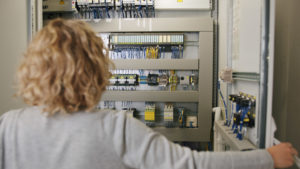At the latest since 2G and 3G switch-offs were announced and in some cases have already become reality, the M2M/IoT world has been keeping its eyes open for new technologies. A promising transmission technology for applications with low power requirements at long range and high building penetration is NarrowBand IoT (NB-IoT for short).
The cost-effective Low Power Wide Area (LPWA) technology is becoming more and more widespread. The GSMA’s Mobile IoT Deployment Map shows in which countries NB-IoT and LTE-M are basically available. In a detailed comparison, we shed light on the jungle of abbreviations and ask questions that will help you find the right uplink technology for your application.
Many hardware components provided by Microtronics use modems with multiple transmission technologies. This can be relevant, for example, if you want to operate your applications in many countries. This is because not all technologies are available in all countries. Via the IoT app (programming of the app), for example, the fixation on NB-IoT can be done as an uplink.
Automatic vs. manual control of the uplink technology
By default, the modem automatically decides which technology to use for the uplink. If no connection can be established via the primary uplink technology, the modem automatically switches to a fallback technology.
The primary uplink technology is always LTE-M1 for the devices concerned (see table). The fallback technology varies. It depends on the modem installed in the device.
If you want to select the uplink technology in your application and, for example, select NB-IoT as the primary or only uplink, you can do this in the IoT app.
ATTENTION: It is essential to note that you must take care of an automatic fallback when using manual control yourself. But you also need to set the number of connection attempts. Features and safety mechanisms with regard to an energy-saving uplink are overridden with manual control and you must take these into account in your IoT app (programming logic).
Which units support manual control?
All NB1-capable devices from Microtronics support manual control of the uplink technology.
Specifically, these are myDatalogEASY IoT, myDatalogEASY IoTmini, rapidM2m C32x, rapidM2M M22x each in the 2G/M1/NB1 variant and rapidM2M T32x.
The following table provides information on the standard primary and fallback technology
| Primary and fallback technology | Device(s) |
| Primary: M1 Fallback: 2G | myDatalogEASY IoT 2G/M1/NB1 myDatalogEASY IoTmini 2G/M1/NB1 rapidM2M C32x 2G/M1/NB1 rapidM2M M22x 2G/M1/NB1 |
| Primary: M1 Fallback: NB1 | rapidM2M T32x |
In both cases the primary technology is LTE-M1, but the fallback technology differs. 2G/M1/NB1 devices use 2G as fallback, while the rapidM2M T32x uses NB1 as fallback. The modem built into the rapidM2M T32x does not support 2G.
How does manual control work in practice?
To fix the uplink technology used to NB-IoT, for example, a special entry must be added in the APP-FLASH Registery in the device. This is possible via the Device Logic (DLO) in the IoT app programming in the rapidM2M Studio.
The following code fixes the uplink technology to NB-IoT:
registryWriteString(RM2M_REG_APP_FLASH, "mdmProfileCfg", "NB-IoT");To switch back to automatic technology control:
registryWriteString(RM2M_REG_APP_FLASH, "mdmProfileCfg", "");ATTENTION: If the control is taken over, the DLO must also ensure that in case of error (e.g.: NB-IoT not available) it is switched back to another technology.
Conclusion
The described function calls show how the uplink of NB-IoT-capable devices can be fixed to this technology. Consider carefully why such a fixation is unavoidable for your application. By fixing the uplink to NB-IoT, for example, you deactivate the automatic control of the uplink technology and are responsible for the fallback management from this moment on.


